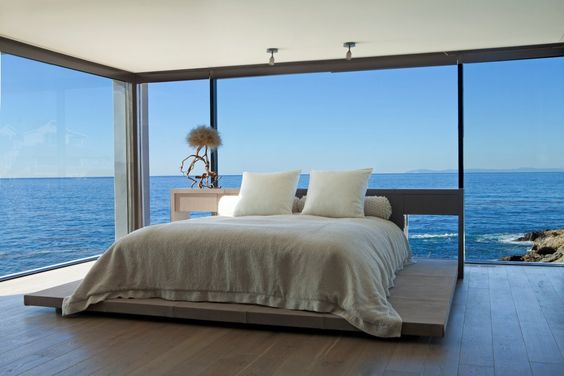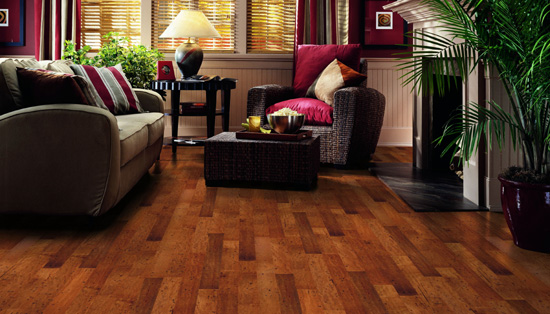
BLOG
When It Comes to Wood Floors, Choose Wisely
Rich wood flooring can spell instant warmth and patina in a home. Here’s an overview that can help you evaluate if wood floors are right for you! Laura Key 310.866.8422
Just as with ties and hem lengths, wood flooring styles change. Colors get darker or lighter; planks get narrower or wider; woods with more or less grain show swings in popularity; softer or harder species gain or lose fans; and the wood itself may be older, newer, or even pre-engineered with a top layer or veneer-glued to a substrate to decrease expansion and contraction from moisture.
Here are key categories for consideration:
Solid Plank
This is what some refer to as “real” wood because the wood usually ranges from three-eighths to three-quarters of an inch in total thickness to permit refinishing and sanding. Thicker floors have a thicker wear layer to allow for more frequent refinishing and sanding, so they can withstand decades of use, says architect Julie Hacker of Stuart Cohen and Julie Hacker Architects. It also can be stained, come from different species of tree, and be sold in numerous widths and lengths:
- Width and length: Designer Steven Gurowitz, owner of Interiors by Steven G., is among those who prefers solid flooring for many installations because of its rich, warm look. Like other design professionals, he’s seeing greater interest in boards wider than the once-standard 2 ¾ to 3 ¾ inches — typically 5 to 6 inches now but even beyond 10 inches. And he’s also seeing corresponding interest in longer lengths, depending on the species. Width and length should be in proportion. “The wider a board gets, the longer the planks need to be, too, and in proportion,” says Chris Sy, vice president with Carlisle Wide Plank Floors. These oversized dimensions reflect the same trend toward bigger stone and ceramic slabs. The downside is greater cost.
- Palette: Gurowitz and others are also hearing more requests for darker hues among clients in the northeastern United States, while those in the South and West still gravitate toward lighter colors. But Sprigg Lynn, on the board of the National Wood Flooring Association and with Universal Floors, says the hottest trend is toward a gray or driftwood. Handscraped, antique boards that look aged and have texture, sometimes beveled edges, are also become more popular, even in modern interiors, though they may cost much more.
- Species and price: Depending on the preference of the stain color, Gurowitz favors mostly mahogany, hickory, walnut, oak, and pine boards. Oak may be the industry’s bread and butter because of the ease of staining it and a relatively low price point. A basic 2 ¼-inch red oak might, for instance, run $6.50 a square foot while a 2 ¼-inch red oak that’s rift and quartered might sell for a slightly higher $8.50 a square foot.
- Maintenance: How much care home owners want to invest in their floors should also factor in their decision. Pine is quite soft and will show more wear than a harder wood like mahogany or walnut, but it’s less expensive. In certain regions such as the South, pine comes in a harder version known as heart pine that’s popular, says Georgia-based designer Mary Lafevers of Inscape Design Studio. Home owners should understand the different choices because they affect how often they need to refinish the wood, which could be every four to five years, says Susan Brunstrum of Sweet Peas Design-Inspired Interior. Also, Sy says that solid planks can be installed over radiant heating, but they demand expert installation.
Engineered Wood
Also referred to as prefabricated wood, this genre has become popular because the top layer or veneer is glued to wood beneath to reduce expansion and contraction that happens with solid boards due to climatic effects, says Sy, whose firm sells both types. He recommends engineered, depending on the amount of humidity. If home owners go with a prefabricated floor, he advises a veneer of at least one-quarter inch. “If it’s too thin, you won’t have enough surface to sand,” he says. And he suggests a thick enough substrate for a stable underlayment that won’t move as moisture levels in a home shift.
His company’s offerings include an 11-ply marine-grade birch. The myth that engineered boards only come prestained is untrue. “They can be bought unfinished,” he says. Engineered boards are also a good choice for home owners planning to age in place, since there are fewer gaps between boards for a stable surface, says Aaron D. Murphy, an architect with ADM Architecture Inc. and a certified Aging in Place specialist with the National Association of Home Builders.
Reclaimed Wood
Typically defined as recycled wood — perhaps from an old barn or factory — reclaimed wood has gained fans because of its aged, imperfect patina and sustainability; you’re reusing something rather than cutting down more trees. Though less plentiful and more expensive because of the time required to locate and renew samples, it offers a solid surface underfoot since it’s from old-growth trees, says Lynn. Some companies have come to specialize in rescuing logs that have been underwater for decades, even a century. West Branch Heritage Timber,for instance, removes “forgotten” native pine and spruce from swamps, cuts them to desired widths and lengths, and lays them atop ½-inch birch to combine the best of engineered and reclaimed. “The advantage is that it can be resanded after wear since it’s thicker than most prefabricated floors, can be laid atop radiant mats, and doesn’t include toxins,” Managing Partner Tom Shafer says. A downside is a higher price of about $12 to $17 a square foot.
Porcelain “Wood”
A new competitor that closely resembles wood, Gurowitz says porcelain wood offers advantages: indestructibility, varied colors, “graining” that mimics old wood, wide and long lengths, quickness in installation, and no maintenance. “You can spill red wine on it and nothing happens; if there’s a leak in an apartment above, it won’t be destroyed,” he says. Average prices run an affordable $3.50 to $8 a square foot. The biggest downside? It doesn’t feel like wood since it’s colder to the touch, Lynn says.
Bottom Line
When home owners are making a choice or comparing floors, Sy suggests they ask these questions:
1. Do you want engineered or solid-based floors, depending on your home’s conditions?
2. Do you want a floor with more natural character, or less?
3. What board width do you want?
4. How critical is length to you in reducing the overall number of seams?
5. What color range do you want — light, medium, or dark?
6. Do you want more aggressive graining like oak or a mellower grain like walnut?
7. Do you want flooring prefinished or unfinished?
8. How thick is the wear layer in the floor you’re considering, which will affect your ability to refinish it over time?
9. What type of finish are you going to use? Can it be refinished and, if so, how?
10. For wider planks that provide greater stability: Where is the wood coming from, how is it dried, what is its moisture content, and what type of substrate is used in the engineered platform?
Thinking of selling your home? A little investment can increase your resale value! Call me for a personal consultation! Laura Key 310.866.8422
Home Improvement with Heart — Just in Time for Valentine’s Day
Roses are red; violets are blue — here are romantic improvements that add value, too. The sensual shower
What makes your honey feel better than a long, soothing shower? (OK. It’s a rhetorical question.) But showering exactly the way you want it is a little luxury that can set the mood for a lot of love.
Programmable showers ($290 to $3,500) let you digitally determine water temperature, pressure, even type of spray. Pulsating, anyone?
And if you want things to get a little steamy in the bedroom, start in the bathroom with asteam shower ($7,000 to $10,000). You’ll need space to put the steam generator — an adjacent closet will do — and you’ll have to make your shower airtight to trap the steam. Or you can buy a prefab unit ($1,000 to $5,000) that you can install yourself or hire a pro to do the wet work ($500 to $1,000).
Read on to learn about more romantic home improvements:
- Squeaky Clean
- Dim the Lights
- Surround Yourself with Sound
- Fireplaces Turn Up the Heat
Squeaky clean
We know you’ll want to be extra clean and coiffed for Valentine’s Day night, so get ready for the fun with an electronic toilet seat that washes and warms, plays music, and sprays pleasant scents.
A couple of years ago, these deluxe seats were hard to come by. Now, big box stores around the country sell these bathroom accessories that fit on top of your toilet ($150 to $600). They come with a host of features, some with slow-closing lids and germ-resistant seats.
If you want to go whole hog, buy complete high-tech toilets that also include LED lights for late night bathroom breaks and no-touch flush ($450 to $1,100).
Dim the lights
Help romance along by avoiding harsh overhead lights and instead installing dimmers on bedroom lights ($16 to $38) or just replacing a few lamps with lower wattage bulbs.
Not only will dim lighting set the mood, but lowering brightness extends the life of bulbs,saving energy and money — and what’s sexier than that?
Surround yourself with sound
Isn’t it romantic to listen to music in the dining room, bedroom, even the bath?
You can go high-end — and high-effort — and have a sound specialist install whole-house sound, which entails running speaker wires through ceilings and walls ($700 to $2,700 per room), and hooking up a pair of speakers ($100 to $2,000 each pair).
Or, you can save some money and install a wireless system yourself. The music is distributed by a computer and sent via router into small player boxes in each room ($400 per room). This DYI project takes a couple of hours.
Fireplaces turn up the heat
Lounging by the fireplace on Valentine’s Day, sipping champagne, eating chocolate-covered strawberries is a dream celebration. But, let’s get down to earth and just settle for the fire.
If you already have a wood-burning fireplace, sweep it out and perform chimney maintenance so your V-Day doesn’t go up in flames.
If you’re missing a place for flames, you could go all out and add a fireplace. If you have a wood-burning fireplace one but never use it because of the hassle, you can retrofit with agas fireplace insert that gives you light and heat with just a flick of a switch ($3,000 to $4,000).
Or, if you’re in a hurry, install a plug-in, electric fireplace that supplies a realistic-looking flame and even heat. Installation is a DIY project. Your biggest hassle will be selecting the location — along a wall or stand-alone — and picking the most romantic-looking mantle surround or fireplace shelf (with mantle package $800 to $1,600).
Tell us what you love about your home.
Thinking of buying or selling your home! You need someone who is experienced, caring and hardworking! Call Laura Key today at 310.866.8422 or email Laura.A.Key@gmail.com

